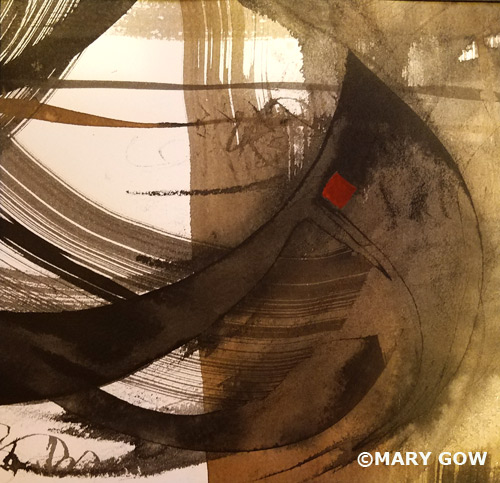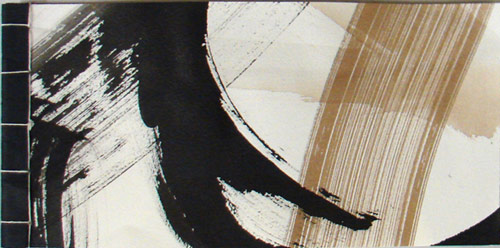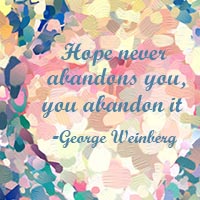Sherrie Lovler began her “Calligraphic Abstractions” workshop with a poem she wrote:
Stay here
my mind
who wants to wander
on her own.
Stay here.
Sit with me.
Enjoy this place
that houses you
and nurtures you
with food and wine.
Stay here
in silence.
As thought arise
let them pass.
. . .
-from “Meditation,” by Sherrie Lovler, p. 57, On Softer Ground: Paintings, Poems and Calligraphy by Sherrie Lovler
The name of the workshop appealed to me because much of my work, especially my cameraless compositions in the darkroom, are calligraphic in nature. You can see examples of them at http://www.marygow.com.
Attending this workshop was a huge treat to my creative self.
I’ve admired Lovler’s work since I saw it at the Friends of Calligraphy’s Kalligraphia show in 2012 at the Skylight Gallery of the San Francisco Public Library. An internationally known calligrapher and artist, she’s author of a book: On Softer Ground: Paintings, Poems and Calligraphy.
Her course included a reminder of the fundamentals of art wrapped into a effectively directed workshop about learning to trust oneself, the marks one makes AND how to make those marks dynamic.
These were two days of intuitive empowerment. A chance to let go and have fun yet understand the required discipline within freedom.

Created this during the workshop. “Calligraphic Abstraction No. 2,” by Mary Gow, Sumi and Walnut Ink on Arches Paper
The workshop totally echoed a love of lines for all involved.
Starting with a Chinese ink brush and dipping it in sumi ink, I drew out thin and gradually thicker lines.
I’ve had a Chinese ink brush since I took a Chinese ink brush painting class in San Francisco’s Chinatown thirty years ago, but I had not exercised it this way before.
Moving the brush from right to left across the page, I eventually began turning the brush onto its side. My pointed brush could make a three-inch thick line!
WRITING EXERCISE WITH FOLDED METAL PEN
Later on Sherrie demonstrated how to make a folded metal pen from a sardine can, a chopstick and tape. That would be a pen we could use to write in our own special shorthand.
One of my favorite exercises we did is one I’d like to repeat at home. We wrote a sentence, then a little larger and quicker, and we kept speeding up the process. The objective was to get into one’s own rhythm, to find one’s own free-form that became excitingly alive lines.
I want to keep working on this with the new folded metal pen.
BIG BRUSHES
The next tools were super wide flat brushes, 6 and 8 inches wide. They reminded me of how I loved using the wide brayer when I was making monotypes a decade ago – my favorite piece using the brayer was highlighted in an article about my work in the San Francisco Examiner in 2011. Now I add extra wide paint brushes to my vocabulary!
Sherrie gave demos of how to use each of the tools she introduced.
ACCENT MARKS
She showed us how to use gold leafing and accent marks to draw the eye into our creations. Note the red square on the image above.
BOOK BINDING
We also learned how to bind a small book!!
Here’s the collaborative cover of my book:

Collaborative Cover, created in “Calligraphic Abstractions” workshop; Mary Gow’s hand bound book
OVERVIEWS
In two days’ time Sherrie also shared her thoughtful handouts that touched upon:
o The Elements of Design
o Brushwork
o Lessons in Color
o Composition
o Sumi-e
o Principles of Wabi-Sabi
o Lettering
o Japanese Stab Binding
INTUITION
What Sherrie said about intuition really spoke to me.
Get to that place of working from your intuition.
All of a sudden I get this quick impulse, and I start trusting it, and let it lead me.
-Sherrie Lovler
In every painting you get lost . . .
There’s a place you get stuck
And you work your way through.
Let the unknown happen in your work
Because it’s a journey.
Sometimes a hard journey.
But you get through it.
-Sherrie Lovler
THE IMPORTANCE OF CLOSER INSPECTION AND CROPPING
When I make art I usually want to relax and let myself wander on the page. In spite of the messy middle stages, there will be an opening at the end. It’s like a storyline within the piece.
Lessons come from the doing, don’t they? On the first day I created a massive array of markings on one of the large sheets. I left that day feeling like it was just a huge mess. I left thinking that on day two I’ll make a new painting. But on day two, after looking more closely, what I thought was a huge mess wasn’t a mess at all. I found some jewels.
Using the cropping method Sherrie repeatedly showed us, I discovered the jewels within this piece, waiting to be discovered.
A major lesson I got from Sherrie was a love of working without thinking about how a painting SHOULD be, and rather letting it happen.
I loved that she doesn’t preplan her paintings. She doesn’t work from a prescribed size. Each painting is a journey that she doesn’t know ahead of time where it will take her.
MAKING A HAND BOUND BOOK
I love books and I loved that Sherrie wanted us to each leave with at least three finished pieces — one being a finished hand bound book with at least three pages.
Wow, I’ve always wanted to do this! And she showed us the Japanese stab binding method.
Now I’ve learned how to hand-bind a small book!
I can’t wait to make more!
HOW I’M EVOLVING
Even during the workshop the look of my daily drawings changed. (I painted after I got home each day).
Attending “Calligraphic Abstractions” affirmed the value of painting ahead of my thinking/critical minds.
It’s in that space of ease and surrender that my best work often emerges.
Sherrie Lovler’s workshop definitely showed me how me to get to that exceptional space more often.
– – – –
Read more about Sherrie Lovler at: http://inkmonkey.com. Find out about her upcoming workshop Nov. 4 & 5 in New York at http://shop.inkmonkey.com/big-magic-p/30058.htm. Treat yourself to her art and poetry at http://artandpoetry.com
